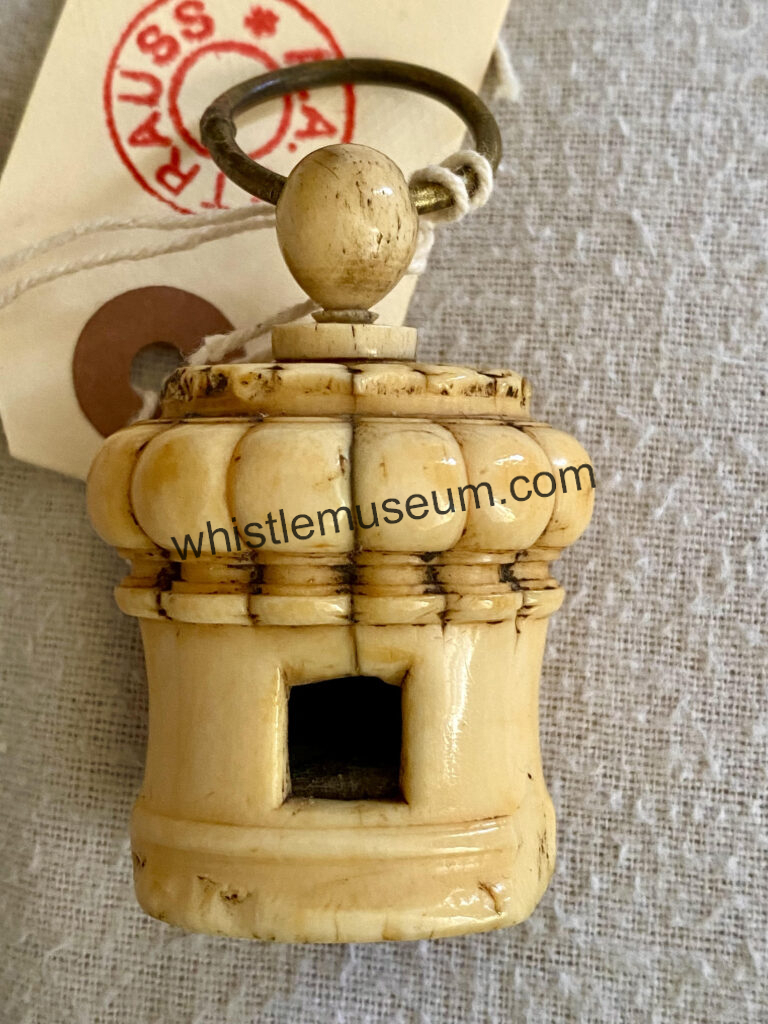
size app. 2″ by 1.5″
Antique whistle review
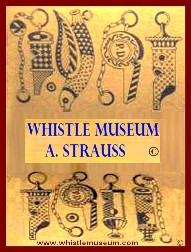
Russian Folk Art Pottery Clay Whistles with Woman Figures. M. Oboeva
(Марианна Обоева)
SHORT INTRO
During the years I developed a growing interest in CLAY & POTTERY WHISTLES,
first as an amateur collector of these and gradually studying and developong this niche of collecting & study. While doing so I had the pleasure of meeting some great & knowledgeable collectors.
Pottery – Clay Whistles had been a subject I had not written about in my blog here, but it is time to start, Clay whistles of different countries Whistles, have typical features , and may be more so with traditional Folk Art.
I have asked my honorable guest, Marianna Oboeva to send 10 photos and few words as intoduction to Russian Pottery Clay Whistles.
She chose the subject of Women Figures (All whistles).
So I leave the stage to a short guest article from Marianna Oboeva a collector,
an Artist and expert on Russian whistles, that chase the theme of feminine figures within the subject of Russian Folk Art Clay whistles, In her own words, with Photos.
A. Strauss
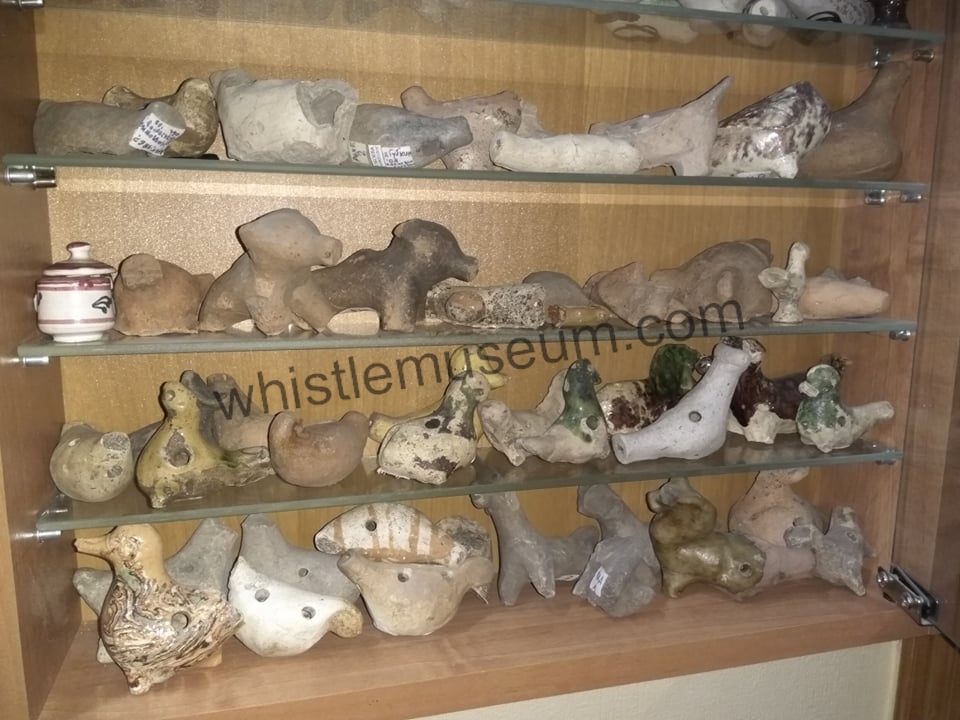
Part III a (See Part I & II William & George Dowler
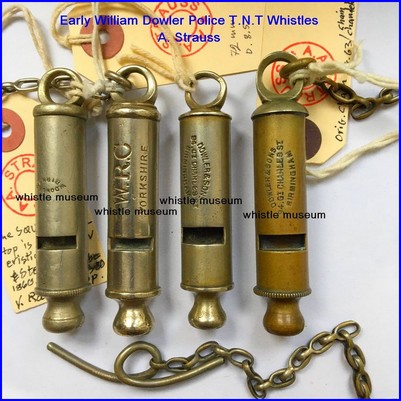
Intro
This article (Part III a) focuses on the Birmingham Whistles,
Military Ornaments and Button manufacturer William Dowler, later ‘William Dowler & Sons’. It is the continuation of the first article, and an on going research of 15 years, some of the first finds were posted here in 2008 and in the Wikipedia
and in 2015- 2016 a revised article about the family which established their business in 1776.
See Link, William & George Dowler which presented
the family’s history and work.
George Dowler had the bigger manufacturing plant and
manufactured whistles which were advertised but not identified to this day, continuing the family’s plants & manufacturing business up to 1870,
it was ‘Willian Dowler’ who was the bigger Whistle manufacturer, He started working independently in 1853 and took over the family’s assets in 1876.
In fact seeing the whole picture we can say that since 1853 William took an independent path and only in 1876 after legal fights gained control of the other various family plants and assets which George was running up to 1870.
Thus between the years 1853 – 1870 There were two different manufacturers;
one is Dowler – Birmingham, the other W. Dowler -Birmingham.
Two important American whistles long searched for by whistle collectors
were found April 2019.
Alexander P Hatch Patents were thought as none existing, since none were seen and the patents applied for stated no model examples.
As to rarity we know of another Plural whistle I discovered with a long time U.S.A collector in 2016, The Police one is the only example I know of.
I imagine there are more to be discovered and there is a good chance that the more fancy variation with few combined whistles as seen on the same patent of the plural whistle is somewhere out there… (so it is with the British Plural one that I posted the patent for last year, no actual example ever seen – it is from the same period)
keep your eyes open it is a treasure probably worth well over a 1000, hopefully with more exposure to the ones that just surfaced more will show up in the future.
It is a pity that there is no information about this inventor who was a citizen of Bridgeport Connecticut at the time, I am sure an extensive research can reveal much more as to his life, Albeit the fact that his whistle patents are among the most cited by whistle inventors, dozens of newly patented whistles since then quote his patents, including 21st century ones.
 Alexander P. Hatch American Whistle patents App. for 1899 & 1901
Alexander P. Hatch American Whistle patents App. for 1899 & 1901
Both are made of Nickel Plated Brass.
I highly recommend reading carefully the patents description & drawings in the next links.
The one on left side is know as the plural whistle and you may see the patent drawings and description HERE at google patent storage
It was found with the original chain in an old bicycle store, in mint condition.
The whistle on the right a tube whistle with unique design and partition is stamped
POLICE DEPARTMENT and has patent date as well see google patents HERE
All rights reseved to A. Strauss Whistle museum
we are glad to help with any questions regarding whistles,
please attach photos to questions, Email: info@avnerstrauss.com
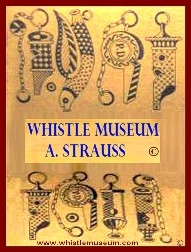
These whistles were registered by ACME WHISTLES,
J. Hudson & Co. Birmingham in 1911 They are similar to button whistles in having an emblem embossed on cap, and are all made of nickel plated Brass.
The Rose
Reg. design # 576579 Model # 618
The Symbols (From Wikipedia)
A shamrock is a young sprig, used as a symbol of Ireland. Saint Patrick, Ireland’s patron saint, is said to have used it as a metaphor for the Christian Holy Trinity.
The thistle has been the national emblem of Scotland since the reign of Alexander III (1249–1286) and was used on silver coins issued by James III in 1470. It is the symbol of the Order of the Thistle, a high chivalric order of Scotland.
The white of York and the red of Lancaster are joined together to make The Tudor rose, marking the union of the two houses and the beginning of a Tudor reign. The Tudor rose was used as a symbol of peace and today it is used as the symbol of England, just as Scotland uses a thistle,
Wales a leek and Ireland a shamrock.
These Registered designs were unique to Acme whistles (see exception* ) and were popular for at least 25 years ahead in different additions and variations. Without going into all the details I will mention that there are dozens of variations, and in GENERAL they vary at 3 main features :
THE TOPS 4 TYPES
1) Bubble top
2) Humpback Tops
3) Humpback with Groove (Implied to whistle by wiring technique)
4) Flying V top (See photos below)
All the three show with these variation:
Early with reg. design number embossed on cap
Later no number NO number embossed to cap
Number embossed to cap at one side
The Tudor Rose Early with 1912 Patent stamp on cap
with or without number (Only on Tudor Rose,*)
The Acme Registered,
The Acme Registered with arched emblem name ( Rose, Shamrock, Thistle)
The Acme Registered and England above the Tooth grip.
No Stamp at all
There may be one having both the emblem name and England, I had not seen one yet.
Dating the variations between 1911 to C. late 1930s I believe, is not an easy task,
but one can rely on the various Tops & Stamps.
The price of whistles in these
whistles varies a lot and the earlier bubble tops first edition is over 100 USD if to judge by the last ones observed on eBay.
NOTE that a whistle can find a Whistle with a BUBBLE TOP and any of the Caps & Stamp variations which more than triples the variations.
Here is the Tudor rose on left (One or two known**)
and on the center and right BOTH ARE Shamrock with two different stamp variations.
So a full set of three Bubble tops
1) Numbered on side / the name of the emblem at front /
2) Another set : Bubble tops / no number on side / and the name of emblem on front / ETC.
There are at least 5 variations of a FULL Trio Bubble tops set
A complete early edition would have 15 whistles 5 sets of three bubble tops
(as in Postage stamps )/ and that does not include the tudor roses,
and and there are still 3 other style tops (None bubble series)
The Tudor Rose Close
Here one may see number P-608282 -12
1912 Patent 608282 on cap and England above tooth grip Observed only on the Tudor rose



Closeup on a Thistle Bubble top and Number on side cap
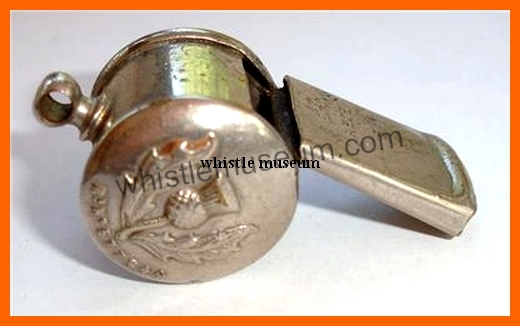
Another previously unknown earlier variation of a Bubble Top Shamrock
surfaced October 21. Found not far from Birmingham.
Probably an earlier pre Registered design experimental model.
Here on right hand is the Beak front view. for comparison.
 A close inspection of construction reveals the DISTINCT Tooth grip location right at the opening of the beak upper lip, as in the 131 Barr St. I had the luck to discover in 2006, a previously unknown one, which was a major find in research & study of Hudson’s escargots timeline. since then few more 131 Barr St. variations were found.
A close inspection of construction reveals the DISTINCT Tooth grip location right at the opening of the beak upper lip, as in the 131 Barr St. I had the luck to discover in 2006, a previously unknown one, which was a major find in research & study of Hudson’s escargots timeline. since then few more 131 Barr St. variations were found.
_
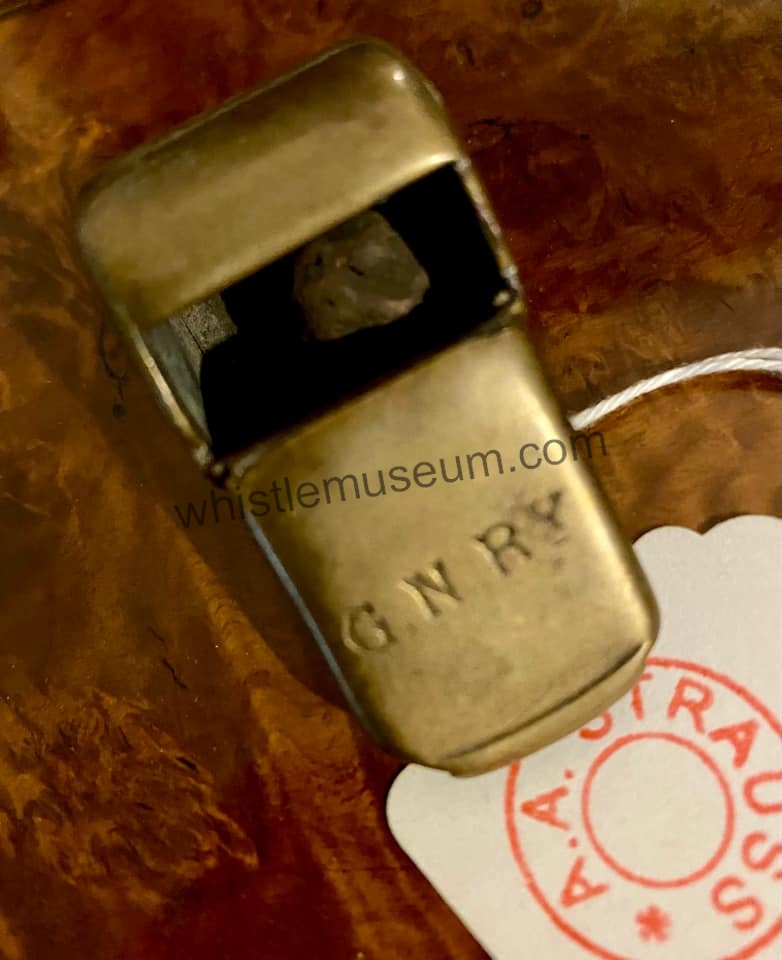 The bubble top at the top one is of older type. (Does remind of Black & Co.)
The bubble top at the top one is of older type. (Does remind of Black & Co.)
With a very short ‘neck’ under bubble and wide base.

So we can conclude that this is an earlier variation, Pre 1911.
Multi view of a ‘named’ stamped Shamrock on beak.
Flying V Top J. Hudson & Co. Patent # 214519 / 1924 Made 1924 onward
Reg. Numbered design embossed on side cap is an earlier 1920s version  Example of a later edition 1930s with Shamrock emblem,
Example of a later edition 1930s with Shamrock emblem,
no emblem name on stamp, no number on cap and
HUMPBACK Top(Hamp top).

Full set of POST 1924 series but still NOTE STAMP VARIATIONS ON FRONT
reflecting period variations 1920s 1930s
While writing I encountered the next whistle which was made earlier has a button like domed sides and has the same feature as the 1911 ones, the Feature of “Folded Beak” construction with a seam which can be seen in the middle of the underside.
It was used by Acme since 1894, (Dixon used it as well at the same time including domed sides, one example found in 2018)
The whistle came in 3 sizes see catalogue excerpt below, here is the smaller one model number 61 and 1/2
It has a brass salesman tag with model number, and it is an earlier one since later they used Aluminum tags.
This type was made by Hudson & Co. Acme Whistles Ltd. up to the 1970s.

Catalogue excerpt showing the 3 domed sides lite construction snail whistles
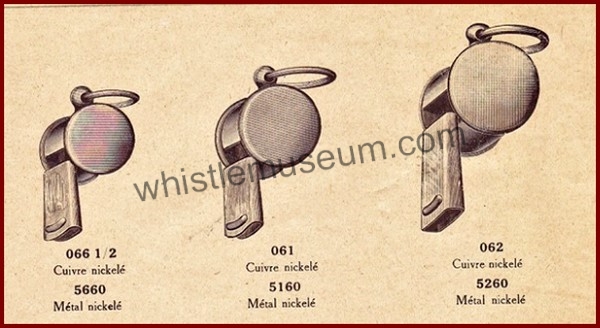 These models were later developed and in the 1930s had 4 sizes
These models were later developed and in the 1930s had 4 sizes
(061 & 1/2 size added ) and another ACME LOGO embossed emblem of THE ACME logo replace the plain domed sides.
Very nice whistles and again many variations, see catalogue for 4 sizes starting
with the same 66 & 1/2 Model as the smaller but now with The Acme Logo side.
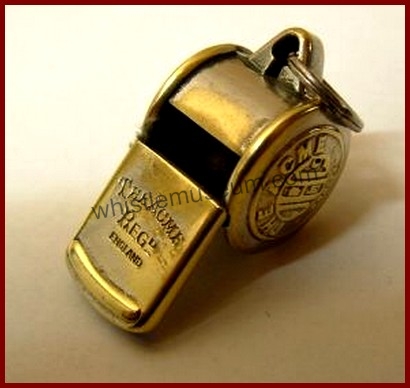
Made in 4 Sizes 1930 Catalogue

There are few more themes of embossed sides button style snail whistles by ACME WHISTLES LTD. ( J. Hudson & Co. ) of which the dog head is the most famous but I will discuss this at some other time.

מוזיאון משרוקיות
Whistles used as Bird Calls are a huge category,
Many of the hand operated type whistles vs. Mouth whistles use a Bellow,
There are few types of Bellows. This time I will review few pedal shape bellows
made of wood & leather. The operation is by hand & the term is used because of the shape albeit I think these could be played by the foot as well.
Here are few examples of Antique Bird Calls – Whistles, 19th century to early 1900, certainly a seldom met with type.
The French and European Continent Bird Calls & are very different than the American ones, and of the far east ones.
These I believed to be folk art work of rural hunters; Tin whistle combining a mechanical element, a Bellow – Pedal shaped Bellow & Whistle, but found out some stamped bellows.
I had looked through many catalogs of bird calls – whistle manufacturers from mid 19th Century onward and had never seen one in a catalogue.
There are four different calls here all from France & Neighbouring countries (Belgium) , I would be glad to see more if the reader happens to have.
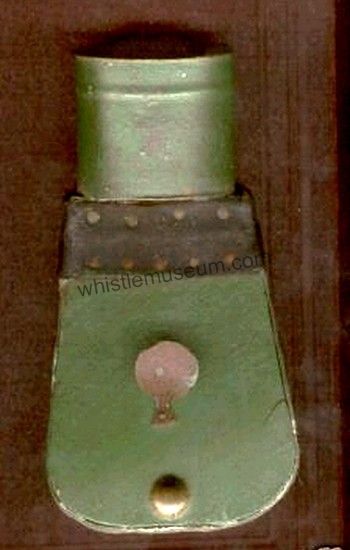
Next is one taken apart, the Tin whistle incorporating a button type whistle can be used inhaling or exhaling it seems that when attached to the Bellow it works by pressing the bellow and it omits a sound when released, but short lite press and release movements produce both sounds.
The calls are made of various materials including a Tin Whistle , Leather, wood, steel spring & iron nails.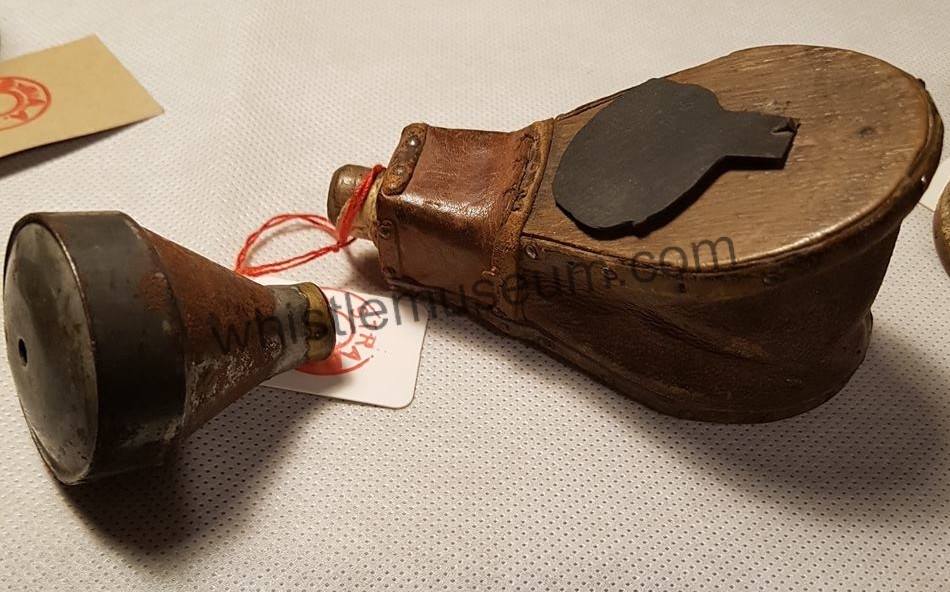
Early ‘Bobbie Whistle’, Whale-Bone Pea Whistle Pre Metropolitan Police Constable Whistle from Hill’s Family.
1821 Early ‘Peeler’, ‘Bobbie Whistle’,Whale-Bone Pea Whistle Pre Metropolitan Police Constable Whistle from Hill’s Family. The next email and photos I quote word for word with some private lines omitted, is from Mr. John Hill Noted for his Great Articles about Historic Places and Cultures among others.
I received it with answers to my questions, I chose to put Some technical and Family history in Bold letters.
Dear Avner
What a pleasant surprise it was to receive your friendly and interesting email. And what a treat it was to discover your fabulous website on whistles – it is absolutely wonderful – congratulations!
My father said it belonged to his great-great-grandfather who was a “Hill” who lived in London and was one of the early “Peelers” (also called “Bobbies” – after Robert or “Bobbie” Peel) or the specialist police set up on the suggestion of Sir Robert Peel in 1814 in Ireland and, in 1829, 1000 men were formed into the “Metropolitan Police Force” who were regularly referred to as “Peelers”. It apparently belonged to him and he carried it while at work. I was lucky enough to inherit it from my father.
We don’t know much about this distant ancestor as the family history seems to have been broken when my grandfather, Alfred Hodson Hill (1887-1977), moved c. 1910 to Montreal, Canada. Before that, his father (who was a silversmith and son of the “Peeler” who owned the whistle) and family moved to Sheffield from London at some unknown date in the 19th century.
That is about as far as the family stories go.
How lovely to hear back from you! I only wish my father was still alive – he would have been so excited to find someone so interested in his family heirloom.
It truly is a unique whistle – i have been very fond of it since childhood and always impressed with the fact that ti is undoubtedly unique.

The whistle is, as you know, carved in the shape of a whale in
(presumably) whale-bone – but maybe from sperm-whale teeth or walrus ivory – I wouldn’t know how to tell the difference – can you help with this? Also, would it be useful for me to gently rub it with mineral oil – or do you have another suggestion – or, should I just leave it alone ?
One blows through the mouth of the whale to make it whistle. It does have a dark brown “pea” (roughly 8 mm. in diameter) inside the whistle, and the hole (where the sound comes out) does not contain a reed or anything other than the original piece of whale bone – with a sharp-edged hole cut into it.
It is just about exactly 8 cm long, 3cm wide at the widest point, 2 cm high
at its highest point (on the top of the whale’s head),
and about 1.5 cm wide at the narrowest place.
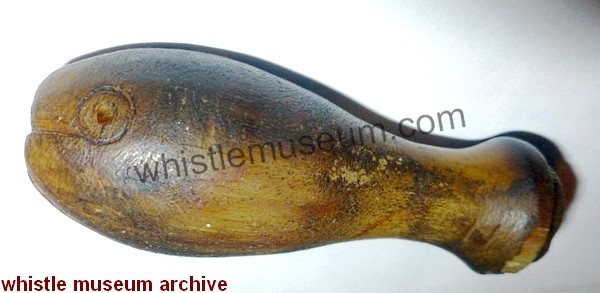
It still has a good-sounding loud, piercing whistle –
I still use it occasionally to call guests from a little cabin we have about 80 metres from our home.
Cheers
John
If I may add I believe the maker was a very fine skilled craftsman who hopefully made other whistles as well. It is also notable that it is a PEA WHISTLE.
Whistle Museum all rights reserved.
Contact: info@avnerstrauss.com
American Bosun Pipes, Bosun Whistles, and More. A.Strauss
Some of you may remember that the old whistle museum website was lost, later I was able to save many posts from there using the Time machine web archive. I started copying some of the 500 posts the photos may not be as good as the original ones and will now have a double ‘whistle museum’ stamp but will suffice. This post was one of many dealing with the subject of Bosun whistles, I will spontaneously bring more while I keep researching and studying. A.S

American Gold Bosun Whistle, 1853 Gold Dollars sides 128mm 29gr,
Cylindrical sound chamber, Spiral wire at Keel end, 2 Filigree bands and mouthpiece, serpentine gun.
A drawer – Cabinet with few dozens of Boatswain’s pipes – Buson whistles.
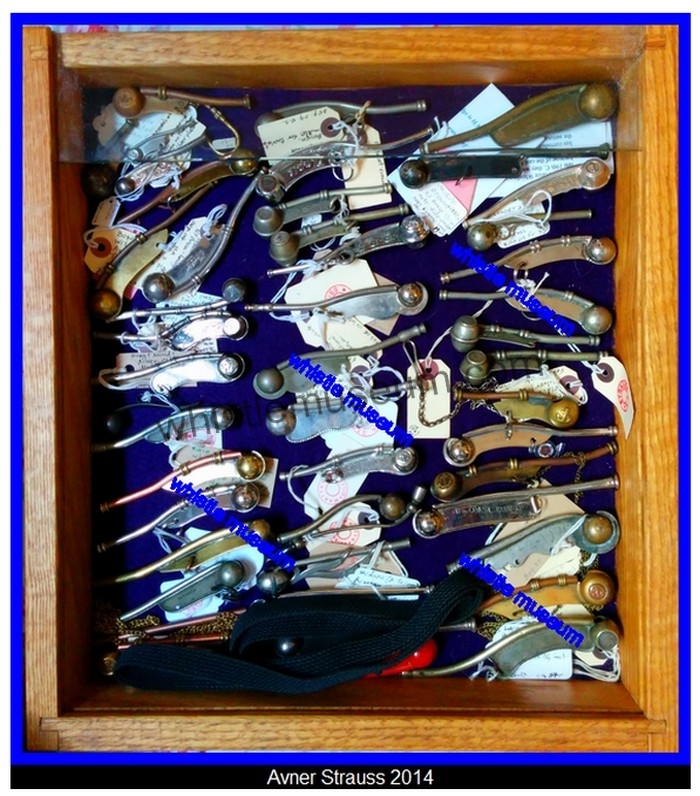
The second from top right hand side is a 140mm old uncleaned silver, I was told by experts that it is from 1820 but it it seems to me as a very early estimate.
The design was certainly a USA style 19th century design since in early 20th century German catalogs of German makers, the same model appears for export as USA style Boatswains pipe.
The Model is marked “STERLING” .
A similar in weight , measures, design and size model stamped
AE & Co. Utica N.Y
In a Triangular stamp
with Plain & almost straight gun
L: 140mm Weight: 24gr
It may be of a later date but I did not take the time to research that company yet.
 This model also in nickel plated brass became the standard for the U.S. Navy, seldom stamped with the marine vessel’s name.
This model also in nickel plated brass became the standard for the U.S. Navy, seldom stamped with the marine vessel’s name.
The fourth from bottom right hand side is stamped , on one side :
U.S.A Pattern (Note the word pattern uses different punches for letters ).
Dated 1936 L.C.H
US CGC Hamilton WHEC-715 and US COAST GUARD
on the other.

It is also stamped under the Keel’s frame LORDSHIP N.Y in between two tiny stamps inside rectangles which are too small to decipher.
LORDSHIP N.Y , They used HLP as their hallmark while their corporate name was “His Lordships Products” until about 1973, they then changed their name to “Lordship Industries” and their hallmark to LI.
The next one is a nicely designed whistle made circa late 1990s early 2000’s as a souvenir often sold in a wood box inlaid with brass anchor.
When I first saw it it was 2004 and was tempted to pay few times more then it’s worth,
It is sold in souvenir shops in many port cities, along the eastern and western coast.
I consider it as an American one since I had not seen it sold anywhere else but it may be made in china or the far east .
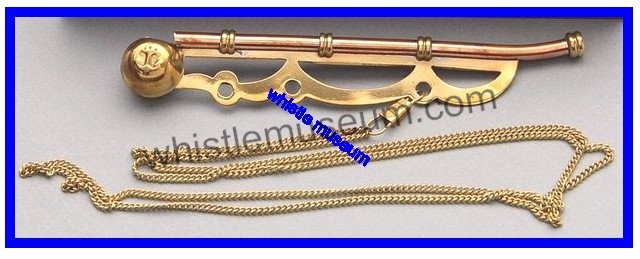
To Be cont. Meanwhile I would like to add that looking at my whistles I found very few American Shaped ones and all together there must be many thousands of ones stamped with a SHIP’s name and US navy ones , so if any of my readers can send photos of some (will be credited) it would be appreciated.
In the meantime I realized that it could be categorized by shapes that can be easily identified and I shall bring DRAWINGS of the typical ones.
Few countries have their own typical design that can be recognized in a glance mostly by looking at the Keel – body.
Russian bosun pipe shape
American Bosun type shape
German Bosun type shape
French Bosun type shape
British bosun type shapes
Chinese Buson shapes and unique features (I did a short post about some here in the past)
Early types
Other countries.
If you have any other examples and wish to contribute
Please email : info@avnerstrauss.com

Whistle Museum, A.Strauss All rights reserved.
Posted by WHISTLE MUSEUM at 3/1/2014 8:38 AM
Categories: By Function:Marine Naval, By Continent or Country:American, A Longer Article, By Material:Metal & Brass:Silver & Gold
Tags: ship Boatswain pipe Boatswain’s call Bosun
Dixon & Sons Round Britannia Metal Whistles & Model #49.
James Dixon started making Britannia Metal (Invented c.1770) whistles Before 1850, Here is a group photo of 16 round pea britannia metal whistles,
11 of which were positively identified as made by Dixon & Sons, two were later found in a German (Marked as such).
Some marked X still need a second close examination dew to newly discovered catalogues by other makers.
Model #10 was made in two sizes, a distinctive Dixon’s Flushed Pillar Top Finial.
See the two sizes made in the group photo above top right is the larger model and 3rd from top left the smaller. 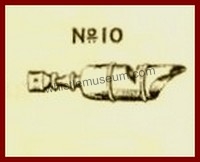 This model was made in two sizes, but other earlier versions are noted;
This model was made in two sizes, but other earlier versions are noted;
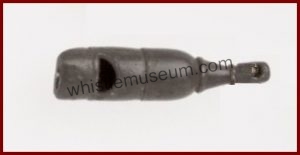 Continue reading Dixon & Sons Round Britannia Metal Whistles & Model #49. Part I.e. A Strauss
Continue reading Dixon & Sons Round Britannia Metal Whistles & Model #49. Part I.e. A Strauss
James Dixon & Sons Round Brass & German Silver Round Whistles (Part I.d.)
A. Strauss

After the First Early period 1800 to 1835 and later up to 1865 which was reviewed here with early examples I move forward to look at some more German Nickel or Nickel Silver & Brass whistles, not it in chronological order.
Cracking the general early date code of whistles in the article about Stevens & Sons was a Benchmark, which enabled a clearer view of another giant whistle maker – Dixon & Sons. At the top a whistle which had been made by James Dixon the founder himself. (See next Paragraph).
This function has been disabled for Whistle Museum.